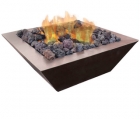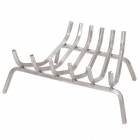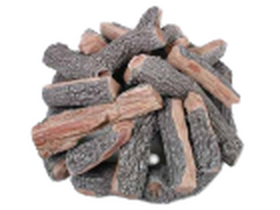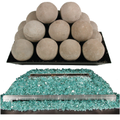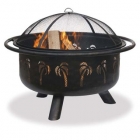Heating - Fireplaces, Heaters, Logs & Accessories
Keep warm indoors and out with our variety of heaters, fire pits, gas logs. Featuring brands like Lynx, Fireside America, Napoleon & more!
Enhance your outdoor living space and heat up your nights with our selection of patio heaters, fire pits and more!
Fireplace & Hearth Info
1. What kind of venting system does my fireplace have?
(This will determine if you need vented or vent-free gas logs)
• A Vented fireplace.
Vented gas logs are the most popular type of gas logs and must be installed in a fully functioning wood burning fireplace. People with a special B Vent or Direct Vent fireplace system will require special logs where traditional “vented” logs are not applicable. One should check the owner’s manual of their manufactured box to ensure they purchase approved logs for their fireplace.
Vented gas logs resemble a realistic wood fire more than vent-free logs. They are very flexible which means logs can be repositioned on most sets. The chimney must remain completely open during operation which limits the heating efficiency.
• A Vent-Free fireplace.
VentFree means "unvented" or “ventless”.
Vent-Free gas logs do not require outside venting and can be installed in either a vent free fireplace or an approved vented fireplace. One should check the owner’s manual of their manufactured box to ensure they purchase approved logs for their fireplace. One should also compare their fireplace with the parameters of the logs they intend to purchase to ensure the appropriate distance to combustible mantles is present.
They are very efficient in providing supplemental heat because the heat produced from vent-free logs can stay in the room they are located in! The look of Vent-free gas logs is less flexible than vented because you can not reposition your logs.
All are equipped with an ODS (Oxygen Depletion Sensitive) Safety Pilot System. These features will stop the flow of gas to the unit in the event that the oxygen level at the pilot is diminished.
2. Which type of fireplace do I have?
• Standard fireplace.
Standard fireplaces have only 1 opening, majority of fireplaces are built this way. The gas logs used for standard fireplaces are only "finished" on the front side. (If you have a single sided fireplace, please select "standard".)
• See-Thru fireplace.
See-Thru fireplaces are double-faced that have openings on two sides (like a fireplace that has an opening facing your living room and one facing your dining room). This is also the most appropriate option if you have a fireplace with openings on 3 sides. See-Thru gas log sets are finished on both sides so they look very nice from any angle.
3. Which size gas logs do I need?
Fireplace Measurements:
- Relevant fireplace dimensions for choosing gas logs include the width of the front opening of the fireplace, the width of the rear fireplace wall, the height of the front fireplace opening, and the fireplace depth from front opening to rear wall
- A minimum of 2 inches on both sides must be maintained between the gas log burner system equipment and the fireplace sidewalls, and some customers prefer up to 6 inches on both sides
- The gas log set chosen should not be longer than the width of the rear fireplace wall
- Fireplace should be a minimum of 12 to 14 inches deep for almost any kind of gas logs
Control Systems:
- Don’t forget – when selecting gas log sizes based on the burner system equipment, you MUST allow room for the fuel control system your gas log burner uses
- For the purpose of choosing gas logs the three basic types of fuel control systems to consider are:
- Manual on/off gas valves
- Manual safety pilot valves
- Millivolt or remote-ready pilot valves
Aesthetic Concerns:
- Choosing a gas log set that is too large for the fireplace can affect the burn and hamper the operation of the fuel control system
- Choosing a gas log set that is too small can diminish the beauty of the hearth setting
- Selecting a gas log set that is either too large or too small can adversely affect proper fireplace drafting
How can you find the right gas log set size for you?
Putting too large of a gas log set into the fireplace is the biggest mistake a consumer makes. The simple fact of being able to fit the set in the fireplace is not the only objective. One will need a certain amount of breathing room to center the set after taking into consideration the space needed to make your gas connections. But wait, there is more. A gas log set with a control valve of any kind requires air space around the valve to prevent the overheating and possible ruining of the valve. Not providing enough space for the gas log set can create a difficult install, an off center log set, operational issues, and even a ruining of a control valve.
The absolute best place to measure your firebox is left to right, approximately half-way back in the firebox (the midpoint). This is usually where the widest part of any log set would sit. In general, it is recommended to have at least 6 inches of clearance for match light, 10 inches for safety pilot, and 12 inches of clearance for remote control. For example: A 24 inch log set would need to have a center width of 30 inches for match light, 34 inches for safety pilot, and 36 inches for remote control. Please keep in mind that this formula of measuring has proven useful when looking at all brands as a whole. Certain models within each brand might require either more or less space than mentioned above. One should compare the manufacturer's sizing requirements to ensure proper fit.
Measure your front width in relation to your usable floor area (Don't just automatically measure from the opening of the fireplace) . Your fireplace may have a wider opening to allow for a door or screen or a section in the back unusable due to the shape.
The fireplace depth could prove inadequate if your fireplace is shallower than 15" for most single sided sets up to 30 inches in width. See through sets, larger width sets, and specialty burners will likely require more depth than 15". You should consult with the manufacturers requirements for depth to ensure your fireplace will fit the log set.
4. How do you want to light your gas log set?
• Match Light
This is only available on Vented Natural Gas Log sets. You light this gas log set by hand with a match or long lighter. It has no pilot or valve assembly at all. You place a match or lighter near the log burner and turn on the gas with your existing gas key valve. Flame height is controlled by adjusting your key valve to let more or less gas flow to the log set. This ignition method is is the least expensive and least problematic with no mechanical parts to go wrong. Simple on and off valve assemblies can often be purchased as accessories to these logs sets if needed. This is a common solution in the event that the existing key valve is not in close proximity to the fireplace opening
• Remote Control
The Remote Control lighting method allows one to operate the log set from a “remote” location away from the fireplace. Remote controlled options include various hand held remotes (basic on/off control, variable flame height control, electronic “pilotless” control, ect..) along with various wall mounted options. These sets feature an included remote pilot valve assembly. Please keep in mind that depending on the manufacturer and remote option you select, you will only have the ability to control certain functions of the log set from the control.
• Manual Safety Pilot
The Manual Safety Pilot lighting method features an included safety pilot valve assembly. You have a pilot light that you can keep lit during the cooler times of the year. This gives you the ability to turn the log set on and off as many times as you want using the control knob without ever holding a match to the burner. The pilot valve has a safety mechanism built in which shuts off the gas supply in the event that the pilot light goes out.
5. Do I need Vented or Vent-Free?
The primary difference is that vent-free gas logs do not require a functioning chimney, which keeps significantly more heat in your home. Vented gas logs resembles a realistic wood fire more than vent-free logs and are very flexible which means logs can be repositioned. However, you might not be so fortunate to be able to choose between one or the other based on your fireplace and what the manufacturer of the logs require. One should check your fireplace in conjunction with the owners manual of the logs you intend on purchasing to ensure you purchase a set that is appropriate.
A direct vent fireplace has a completely sealed combustion chamber which allows it to vent directly out a side wall or through the ceiling of your home. The benefit of this system is that it brings in air from the outside of the home rather than using the room air.
A ventless (or vent-free) fireplace uses room air from the home for combustion and it also releases the combusted exhaut (which carries harmful substances and chemicals including carbon monoxide and carbon dioxide) back into the home. Ventless fireplaces will likely cause poor indoor air quality and moisture issues in your home.
6. Types of Fuel Control Systems
|
Manual On/Off Valve |
Manual Safety Pilot Valve |
Millivolt (Remote-ready) Pilot Valve |
|
This is the simplest type of fuel control system, the one many of us used in years past. You turn a manual on/off valve open and closed by hand, light the gas log burner with a match, and adjust the flame height via the valve by hand, as well. |
This fuel control system is similar to that used on a furnace or water heater. There are ‘Off’, ‘Pilot’, and ‘On’ positions. Initially you have to turn the valve to the ‘Pilot’ position and light the pilot with a match, but after that you can turn the gas logs on and off by switching between the ‘On’ and ‘Pilot’ positions. The pilot will stay lit until turned to ‘Off’ or blown out, at which point it automatically shuts off gas flow. Propane gas logs require a safety pilot valve of some kind. |
This is very similar to a manual safety pilot valve, except a remote-ready pilot valve can be connected to an optional device to remotely turn the gas on or off or control the flame height. These devices range from inexpensive remotes or wall switches designed only to turn the gas on and off to more expensive remotes that can adjust flame heights and set timers, or even thermostats that will turn the flame down once the desired temperature is reached. |
|
Advantages
|
Advantages
|
Advantages
|
|
Disadvantages
|
Disadvantages
|
Disadvantages
|
This reference is somewhat general and some gas log sets may have individual space requirements, so read the information about individual gas log sets carefully!
|
Manual On/Off Valve |
Manual Safety Pilot Valve |
Remote-ready Pilot Valve |
|
No pilot kit is involved, so all you need is 2 inches of clearance between the burner system and the fireplace on each side. Measure the fireplace’s front opening width, subtract 4 inches, and the resulting length is the largest size gas log set your fireplace can accommodate. |
The safety pilot valve occupies some space, so again measure the front opening width of the fireplace, but subtract 8 total inches rather than the 4 inches required for the manual on/off valve. The resulting measurement is the largest gas log set equipped with a manual safety pilot valve your fireplace can handle. |
This is about the same as the manual safety pilot valve calculation, but in this case subtract 12 inches from the opening width to find the largest gas log set equipped with a remote-ready pilot valve suitable for |
7. Advantages Of Gas Logs?
Simplicity:
Gas Logs Are Simple To Operate! Gas logs can be conveniently started at the turn of a valve or with an on/off switch. Once the logs are in place they are permanent. No constant hassle with the changing out of real wood logs.
Efficient & Long-lasting:
Gas Logs Outlast Conventional Wood! Since gas logs do not require electricity, the are a great source of heat and light during a power outage. They offer enjoyment year after year without having to worry about stocking and replacing firewood.
Environmentally Friendly
Burning Gas Logs Preserves The Environment! Gas logs burn cleaner than wood, reducing air pollutants. Dangerous flying sparks and dirty ashes are eliminated. Creosote build-up in the chimney, a common cause of fires, is also significantly reduced by the cleaner burning gas fuel.
Cost Effective:
Gas Logs Cost Less! Gas logs cost a fraction of what wood logs cost per hour to operate

